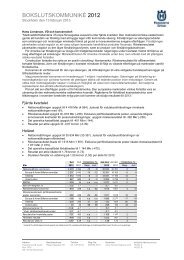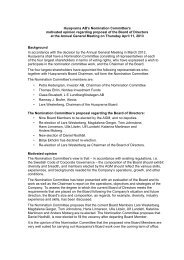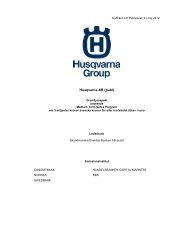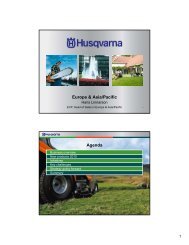Annual Report 2009 - Husqvarna Group
Annual Report 2009 - Husqvarna Group
Annual Report 2009 - Husqvarna Group
Create successful ePaper yourself
Turn your PDF publications into a flip-book with our unique Google optimized e-Paper software.
Notes <strong>Husqvarna</strong> <strong>Annual</strong> <strong>Report</strong> <strong>2009</strong> 55<br />
Amounts in SEKm unless otherwise stated.<br />
Leasing<br />
A finance lease is a lease that transfers substantially all of the<br />
risks and rewards associated with ownership of an asset. Title<br />
may or may not be eventually transferred. Assets under<br />
finance leases in which the <strong>Group</strong> is a lessee are recognized in<br />
the balance sheet and the future leasing payments are recognized<br />
as loan. Expenses for the period correspond to the<br />
depreciation of the leased asset and interest cost of the loan.<br />
Finance leases are capitalized at the inception of the lease at<br />
the lower amount of either the fair value of the leased property<br />
or the present value of the minimum lease payments. The<br />
leased assets are depreciated over their estimated useful<br />
lives. If no reasonable certainty exists that the lessee will<br />
obtain ownership by the end of the lease term, the assets are<br />
fully depreciated over the shorter period of either the lease<br />
term or the useful life of the assets.<br />
Apart from finance leases all other leases are categorized<br />
as operating leases. The payments made under operating<br />
leases are recognized in the income statement on a straightline<br />
basis over the leasing period.<br />
The <strong>Group</strong> rents certain production facilities, warehouses<br />
and office premises as well as certain office equipment under<br />
leasing agreements. Most leasing agreements in the <strong>Group</strong><br />
are operating leases.<br />
Inventories<br />
Inventories and work in progress are valued at the lower<br />
amount of cost and the net realizable value. Net realizable<br />
value is defined as the estimated selling price in the ordinary<br />
course of business less the estimated costs of completion and<br />
the estimated costs necessary to execute the sale at market<br />
value. The value of inventories is determined by using the<br />
weighted average cost formula. Gains and losses previously<br />
deferred in equity on hedged forecast transactions are also<br />
included in the initial measurement cost of the inventory.<br />
Appropriate provisions have been made for obsolescence.<br />
Trade receivables<br />
Trade receivables are initially recognized at fair value and subsequently<br />
measured at amortized cost using the effect ive<br />
interest method, less provision for impairment. A provision for<br />
impairment of trade receivables is established when there is<br />
objective evidence that <strong>Husqvarna</strong> will not be able to collect<br />
all amounts due according to the original terms of the receivables.<br />
The amount of the provision is the difference between<br />
the asset’s carrying amount and the present value of estimated<br />
future cash flows, discounted at the effective interest<br />
rate. The change in the amount of the provision is recognized<br />
in selling expense.<br />
Cash and cash equivalents<br />
Cash and cash equivalents consist of cash on hand, bank<br />
deposits and other short-term highly liquid investments with<br />
maturities of three months or less.<br />
Provisions<br />
Provisions are recognized when the <strong>Group</strong> has a present obligation<br />
as a result of a past event, it is probable that an outflow<br />
of resources will be required to settle the obligation, and<br />
a reliable estimate can be made of the amount of the<br />
obligation. The amount recognized as a provision is the best<br />
estimate of the expenditure required to settle the present<br />
obligation at the balance sheet date. Where the effect of the<br />
time value of money is material, the amount recognized is the<br />
present value of the estimated expenditures.<br />
Provisions for warranties are recognized at the date of sale<br />
of the products covered by the warranty and are calculated<br />
on the basis of historical data for similar products.<br />
Restructuring provisions are recognized when the <strong>Group</strong><br />
has adopted a detailed formal plan for the restructuring and<br />
has either started the implementation of the plan or<br />
communicated its main features to those affected by the<br />
restructuring.<br />
Pensions and other post-employment benefits<br />
Pensions and other post-employment benefit plans are classified<br />
as either defined contribution plans or defined benefit<br />
plans.<br />
Under a defined contribution plan, the Company pays fixed<br />
contributions into a separate entity and will have no legal<br />
obligation to pay further contributions if the fund does not<br />
hold sufficient assets to pay all employee benefits. Contributions<br />
are expensed when they are due.<br />
All other pensions and other post-employment benefit<br />
plans are defined benefit plans. The Projected Unit Credit<br />
Method is used to measure the present value of the obligations<br />
and costs. The calculations are made annually using<br />
actuarial assumptions determined close to the balance sheet<br />
date. Changes in the present value of obligations due to<br />
revised actuarial assumptions and differences between the<br />
expected and actual return on plan assets are treated as actuarial<br />
gains or losses. Actuarial gains or losses are amort ized<br />
over the employees’ expected average remaining working<br />
lifetime in accordance with the corridor approach.<br />
Net provisions for post-employment benefits in the balance<br />
sheet represent the present value of the <strong>Group</strong>’s obligations<br />
at year-end less the market value of plan assets, unrecognized<br />
actuarial gains and losses and unrecognized past-service<br />
costs.<br />
Borrowings<br />
Borrowings are initially recognized at fair value net of transaction<br />
costs incurred. After initial recognition, borrowings are<br />
valued at amortized cost using the effective interest method.<br />
Borrowings are classified as current liabilities unless the<br />
<strong>Group</strong> has an unconditional right to defer settlement of the<br />
liability for at least 12 months after the balance sheet date.<br />
Accounting of derivative financial instruments<br />
and hedging activities<br />
Derivatives are initially recognized at fair value on the date on<br />
which the derivative contract is entered into and are subsequently<br />
remeasured at their fair value. The method of recognizing<br />
the resulting gain or loss depends on whether the<br />
derivative is designated as a hedging instrument, and if so,<br />
the nature of the item being hedged. The <strong>Group</strong> designates<br />
certain derivatives as either hedges of highly probable forecast<br />
transactions (cash-flow hedges), or hedges of net investments<br />
in foreign operations, and the hedged risk is defined as<br />
the risk of changes in the spot rate.

















